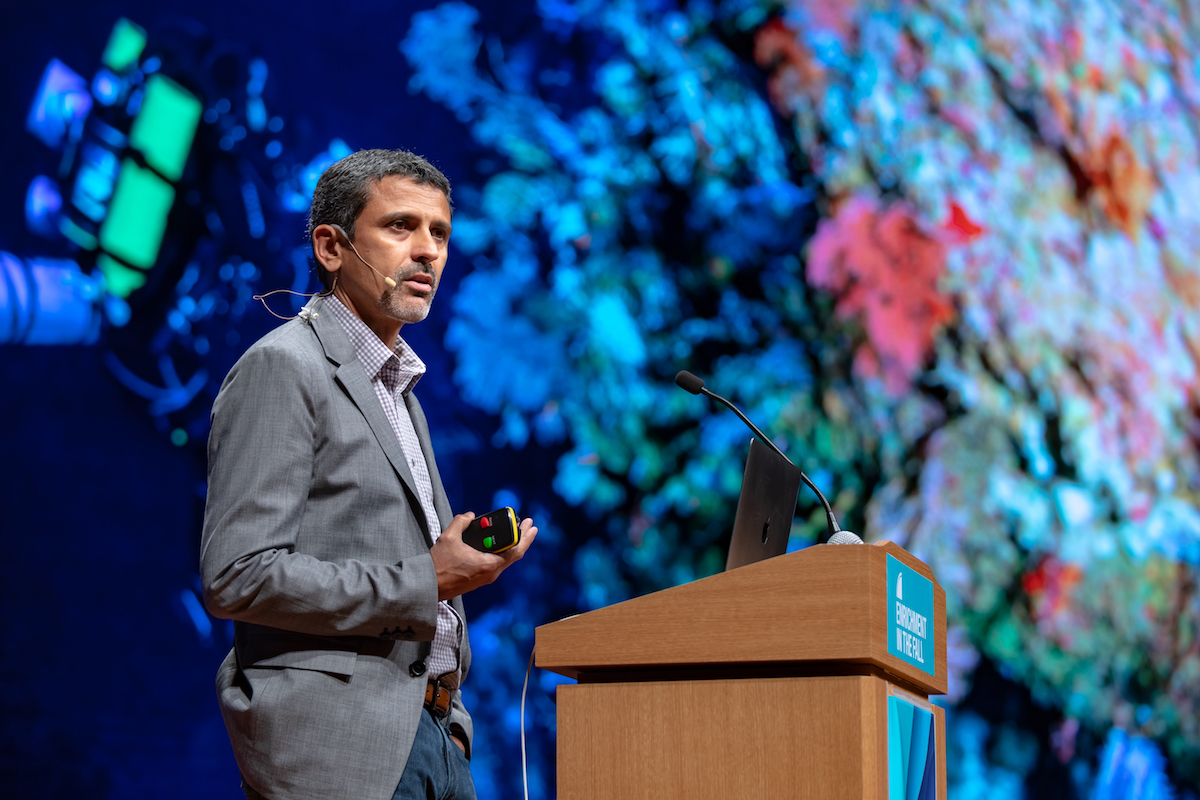Diving into unchartered waters of the ‘twilight zone’

Dr. Luiz Rocha from the California Academy of Sciences—who is also a National Geographic explorer—discusses coral ecosystems at deep depths during an Enrichment in the Fall lecture on October 21 on campus. Photo by Asharaf Kannearil.
-By Lulwah Shalhoub, KAUST News
Climate change and global warming are two of the major challenges of the century, both for the environment and for living creatures. For marine life, the problem goes as deep as the deepest oceans and strips colorful corals of their distinctive beauty, as bleaching is associated with rising water temperatures.
During a keynote as part of the University's Enrichment in the Fall program, Dr. Luiz Rocha, who studies the ecology and evolution of coral reefs fishes, said the connection between the high temperature of water and the death of corals is very strong. If the temperature stays warm in that area long enough, corals will eventually die.
"The biggest problem by far has been climate driven change that causes coral reefs to bleach," said Rocha, who is also curator of ichthyology at the California Academy of Sciences in San Francisco and a National Geographic explorer.

National Geographic explorer Dr. Luiz Rocha talks about marine biodiversity in deep waters during his October 21 Enrichment in the Fall keynote lecture. Photo by Asharaf Kannearil.
This relationship requires very specific conditions to occur. One of the main conditions is a stable temperature that both organisms are used to, but in some places, when the temperature rises above a certain level, the coral gets stressed, and it expels the microalgae. When it expels the algae, the coral bleaches and turns white because the algae that gave color to its tissue are gone.
"The corals are the builders of the ecosystem and everything else is related to what the corals do. If the corals are dying, everything else in the coral reef suffers," Rocha said.

Dr. Luiz Rocha outlines coral bleaching during his Enrichment in the Fall keynote lecture on campus. Photo by Andrea Bachofen-Echt.
As he dove into unchartered waters, Rocha's mission was to explore the mesophotic coral ecosystems (MCEs) that are commonly referred to as the "twilight zone" of coral reefs.
The twilight zone lies between 60 to 150 meters of depth and is home to a diverse animal community that remains hard to explore. Submarines are not the right tool for the job as they are noisy and bright and scare animals away.
As an alternative method, Rocha asked, "Why don't scientists just do the technical diving and use technical gear?" However, the deeper divers go, the more toxic oxygen and nitrogen—which divers need—become in these waters. Divers then have to breathe helium, which comes at a hefty price—as expensive as $10 per breath.

Dr. Luiz Rocha, a 2018 Enrichment in the Fall keynote speaker, discusses his research work into coral ecosystems at deep depths at an interview on campus before his October 21 lecture. Photo by Asharaf Kannearil.
"The rebreather" technology allows diving explorers to stay in deep water for up to nine hours. The technology is a compact system which recirculates the breathing gas as the diver exhales back into the system. The gas goes through a filter that removes all the toxics from carbon dioxide. The electronic system adds oxygen only as needed and the helium comes back to be rebreathed.

'The rebreather' technology discussed by Dr. Luiz Rocha during his 2018 Enrichment in the Fall keynoteallows diving explorers to stay in deep water for up to nine hours. Image courtesy of Shutterstock.

Audience members enjoyed hearing about the diversity of organisms in deep waters during Dr. Luiz Rocha's Enrichment in the Fall presentation on campus. Photo by Andrea Bachofen-Echt.
Thanks to deep diving excursions into the twilight zone, up to 153 new fish species were discovered over the past two decades in several areas, including in Fiji, where 46 species were discovered in 2002, and in Christmas Island, the Caroline Islands and the Philippines.
Related stories:
- New perspectives on symbiosis research
- A truly global challenge
- Providing solutions to climate change
- Isotope science and culture: highlights of the 2018 IsoEcol conference
-
Finding Nemo's genes

